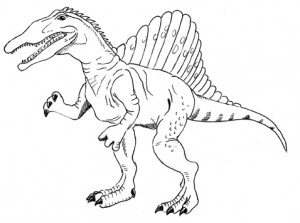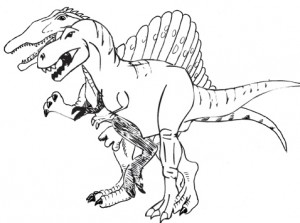Why did Spinosaurus have a Sail on its Back?
Theories on Spinosaurus – the Sail-back Dinosaur
Spinosaurus was one of the most spectacular looking meat-eating dinosaurs. Like most of the big carnivores, fossils of this bizarre animal are extremely rare. As animals move up the food chain, their numbers become smaller and they make up an ever-decreasing proportion of the ecosystem, which means it is less likely for any of them to be preserved as fossils. For example, scientists in Canada and the western United States can conduct studies on duck-billed dinosaurs (herbivores) that involve hundreds of skeletons, yet in contrast there are only about 30 known fossils of Tyrannosaurus rex.
Spinosaurus
Spinosaurus is even less well-known, this is because a number of factors have conspired to leave us with little fossil evidence of this dinosaur. There are few Spinosaurus remains partly because as a meat-eater and at the top of the food chain there were fewer of them around at any one time and also because the area of Africa that Spinosaurus lived in during the Cretaceous has still to be fully explored. Unfortunately, the 20th Century has been particularly unkind to this dinosaur, with the best fossils of Spinosaurus being destroyed in a bombing raid over Germany during WWII.
Ernst Stromer von Reichenbach, a German palaeontologist and geologist found the first fossils of Spinosaurus (1912), in an area approximately 300 kilometres south-west of Cairo, Egypt. A number of German funded and led expeditions were despatched to north Africa between 1911 and 1914, Spinosaurus was named and described by Ernst Stromer von Reichenbach in 1915. Estimates of its size vary, with most scientists stating that these animals grew to lengths in excess of 12 metres and they may have weighed as much as 4 tonnes.
An Illustration of Spinosaurus (S. aegyptiacus)
Picture credit: Everything Dinosaur
Over the last ten years or so more partial remains of spinosaurs have been found. There are now believed to have been two species of Spinosaurus around during the Cretaceous (approximately 95 million years ago). The larger species S. aegyptiacus from Egypt and a less well known, smaller species from Morocco (S. marocannus), which was named and described in 1996. Spinosaurus marocannus has yet to be universally accepted as a different species, it is still classified as “Nomen dubium” – a name given to an animal whose validity is still in doubt.
In 2005, Cristiano Dal Sasso and his colleagues at the Civic Natural History Museum in Milan, Italy, carried out a study of the partial remains of a Spinosaurus skull that had been discovered just a few years earlier. The assumption had always been that the original Spinosaurus unearthed in 1912 was a sub-adult and not fully grown. Using those parts of the skull that they had – mainly parts that formed the upper jaw, this team of scientists calculated skull length and from this they deduced the overall size of this particular specimen. They concluded that the skull would have exceeded 1.75 metres in length, making it comparable to the size of the biggest tyrannosaur or allosauroid skulls known.
The Biggest Meat-eating Dinosaur
They concluded that this creature would have been between 16 – 18 metres long (approaching 60 feet in length) and would have weighed as much as 9 tonnes. Spinosaurus could lay claim to the title of the biggest meat-eating dinosaur known.
A Size Comparison between Spinosaurus aegyptiacus and Tyrannosaurus rex
Picture credit: Everything Dinosaur
The above diagram attempts to compare the projected sizes of T. rex and the largest known species of Spinosaurus. Scientists are still unsure how much Spinosaurus weighed. It may not have been as heavy as Tyrannosaurus rex but if the Italian led team from the Civic Natural History Museum of Milan are correct, the largest spinosaurs would have been longer than the biggest known T. rex. The figure of a man (approximately 1.80 metres tall) is given to provide further scale.
The most striking feature about Spinosaurus was undoubtedly its huge sail. Again estimates vary as to the size of the sail, but most scientists agree that at its highest point it was between 1.5 to 2 metres tall. Very few fossils of these spines (called neural spines) have been collected. For example, in the original 1912 specimen only 8 elements of individual neural spines are known, most of which were not found in association with the back vertebrae. The German scientists had no real idea how these spines fitted together with the backbone, or indeed which order they should be put in. The photograph of the team’s attempts to reconstruct the backbone show the spines arranged in a nice convex pattern, but the vertebrae connected to the spines for the reconstruction are clearly in the wrong order.
The spines themselves seem to have a broadened out top end, they are sort of spoon shaped or spatula like. Similar shaped neural spines can be found in bison, these spines help support a fleshy lump on the backs of these animals where fat is stored to help the animals through leaner times.
There is only limited photographic evidence of Ernst Stromer von Reichenbach’s work on the Spinosaurus fossils, most of the photographs were destroyed by the Allied bombing raid on Munich in 1944.
A number of theories about the sail have been put forward. It has been suggested that such a big animal could use the structure on its back like a sail on a ship to help it move or at least keep stable as it lumbered along. A similar theory was put forward many years ago concerning the function of the sail on the back of a mammal-like reptile called Edaphosaurus.
A Piscivore
It is believed that Spinosaurus was a fish eater. There is no proof for this, the arms of Spinosaurus have never been found but as the jaws are similar to Baryonyx (a relative, which scientists believe did eat fish), perhaps the sail was used to cast a shadow over water to attract fish or to let Spinosaurus see fish in the water without the reflection from the water surface to distract it.
Could the sail have acted as a device for helping Spinosaurus warm up quickly in the beginning and end of the day, as well as helping to keep it cool under the mid-day sun? Palaeontologists believe that the sail area was well supplied with blood vessels, turning to face the sun in the morning would have helped this animal to warm up quickly, perhaps giving it an advantage over the other meat-eaters that roamed north Africa at this time. Turning directly into the sun at mid-day would have exposed only a small portion of the sail’s surface area to the sun and this would have helped Spinosaurus keep cool.
Another theory has been put forward recently by a young dinosaur fan called Ewan. He thinks that the sail on the back of Spinosaurus could be a mock spine, that could put off an attacking dinosaur. We know that Spinosaurus shared its world with some very ferocious carnivores such as Carcharodontosaurus, the spine could make Spinosaurus look bigger than it actually was so it could intimidate predators. We know from bite marks on hadrosaurs that the back was a favourite area to target for the big meat-eaters, perhaps the spine helped protect the vulnerable back and neck of Spinosaurus. Many animals use spines as a form of defence, so why not a Spinosaurus. It is certainly an interesting theory and without more fossil evidence like the other theories concerning the sail on a Spinosaurus it cannot easily be disproved.
Our own favourite theory concerns a theory put forward recently from palaeontologists who studied the remaining Spinosaurus fossils as well as the drawings made by the German team under the supervision of Ernst Stromer von Reichenbach. Fortunately, many of these drawing survived the war and they helped to give today’s scientists a unique insight into how flexible the backbone of Spinosaurus was. From the fragmentary remains and the beautiful pencil and ink drawings from the last century, scientists have calculated that the backbone was quite flexible. Perhaps Spinosaurus was able to flex its back and spread out the sail like an enormous fan. If the sail had been brightly coloured it could have been used to attract a mate or to scare off rivals. Due to recent studies of theropod brain cases and other evidence amassed from studies of the skulls and in the particular the area where the optic nerve was present, it is now thought that these dinosaurs had excellent eyesight and colour vision, so a big, colourful signalling device would have been extremely useful.
We are indebted to Ewan and his father for helping to write this article.
To view the range of Spinosaurus models and figures available from Everything Dinosaur: Spinosaurus and Prehistoric Animal Models.



